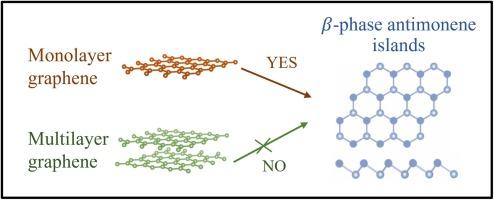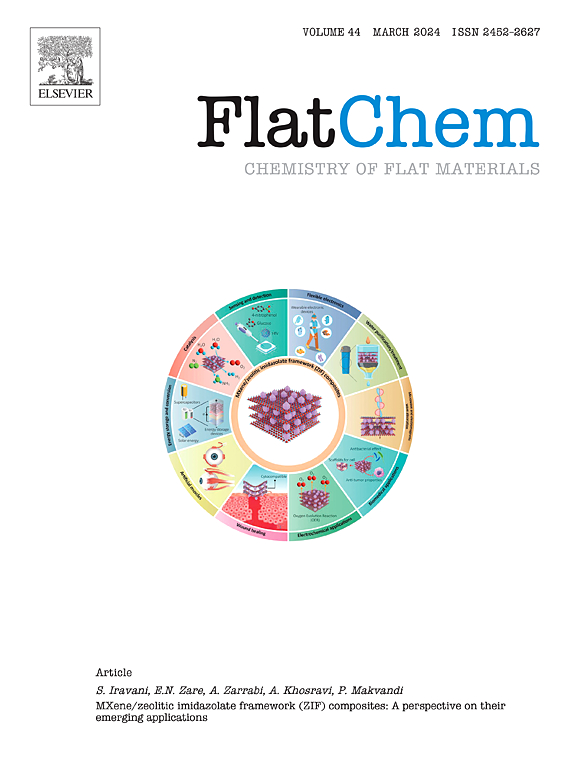Investigating the role of graphene in the formation and stability of β-phase antimonene islands
IF 5.9
3区 材料科学
Q2 CHEMISTRY, PHYSICAL
引用次数: 0
Abstract
Two-dimensional materials have shown tremendous potential for various technological applications. Particularly, 2D antimony exhibits high applicability in electronics, sensors, and batteries. This 2D material, known as antimonene, presents two stable phases: (rectangular lattice) and (honeycomb lattice), whose formation depends on the substrate where antimony is deposited. In this study, we investigated the growth of antimonene islands on graphene, forming an antimonene/graphene heterostructure. To demonstrate the significance of graphene in the synthesis of antimonene, we also studied antimony deposited on a bare copper foil similar to the one used for the graphene substrate. Antimony deposition exhibits the phase antimonene structure when deposited on top of monolayer graphene, but not when deposited on a bare copper foil, nor on top of multilayer graphene. Additionally, we investigated the stability of the heterostructure after exposure to air. Pure antimony islands are formed when evaporated in high vacuum on top of graphene and copper substrates, and antimony atoms oxidize upon exposure to air. After annealing the sample in ultra-high-vacuum at temperatures lower than 200 C, more than half of pure antimony is recovered and almost all oxidized antimony is desorbed from the graphene substrate. In contrast, almost none of the oxidized antimony is desorbed from the bare copper substrate, highlighting the key role of the heterostructure on the formation and preservation of the physical and chemical properties of the deposited 2D material.

研究石墨烯在β相锑岛的形成和稳定性中的作用
二维材料在各种技术应用中显示出巨大的潜力。尤其是二维锑,在电子、传感器和电池领域具有很高的应用价值。这种被称为锑的二维材料呈现出两种稳定相:α(矩形晶格)和β(蜂窝晶格),其形成取决于沉积锑的基底。在本研究中,我们研究了锑岛在石墨烯上的生长,形成了锑/石墨烯异质结构。为了证明石墨烯在锑的合成中的重要性,我们还研究了沉积在裸铜箔上的锑,该铜箔与石墨烯基底所用的铜箔类似。当锑沉积在单层石墨烯上面时,会呈现出 β 相锑结构,而沉积在裸铜箔上或多层石墨烯上面时则不会。此外,我们还研究了异质结构暴露在空气中后的稳定性。在高真空中蒸发到石墨烯和铜基底上时,会形成纯粹的锑岛,暴露在空气中时锑原子会氧化。样品在温度低于 200 °C 的超高真空中退火后,一半以上的纯锑被回收,几乎所有氧化锑都从石墨烯基底中解吸出来。相比之下,几乎没有氧化锑从裸铜基底中解吸出来,这凸显了异质结构在形成和保持沉积二维材料的物理和化学特性方面的关键作用。
本文章由计算机程序翻译,如有差异,请以英文原文为准。
求助全文
约1分钟内获得全文
求助全文
来源期刊

FlatChem
Multiple-
CiteScore
8.40
自引率
6.50%
发文量
104
审稿时长
26 days
期刊介绍:
FlatChem - Chemistry of Flat Materials, a new voice in the community, publishes original and significant, cutting-edge research related to the chemistry of graphene and related 2D & layered materials. The overall aim of the journal is to combine the chemistry and applications of these materials, where the submission of communications, full papers, and concepts should contain chemistry in a materials context, which can be both experimental and/or theoretical. In addition to original research articles, FlatChem also offers reviews, minireviews, highlights and perspectives on the future of this research area with the scientific leaders in fields related to Flat Materials. Topics of interest include, but are not limited to, the following: -Design, synthesis, applications and investigation of graphene, graphene related materials and other 2D & layered materials (for example Silicene, Germanene, Phosphorene, MXenes, Boron nitride, Transition metal dichalcogenides) -Characterization of these materials using all forms of spectroscopy and microscopy techniques -Chemical modification or functionalization and dispersion of these materials, as well as interactions with other materials -Exploring the surface chemistry of these materials for applications in: Sensors or detectors in electrochemical/Lab on a Chip devices, Composite materials, Membranes, Environment technology, Catalysis for energy storage and conversion (for example fuel cells, supercapacitors, batteries, hydrogen storage), Biomedical technology (drug delivery, biosensing, bioimaging)
 求助内容:
求助内容: 应助结果提醒方式:
应助结果提醒方式:


